Sonic the Hedgehog History: In honor of Sonic's birthday, Matt reminisces about the hedgehog's past and looks to the future to see where he's rapidly heading in his third decade.
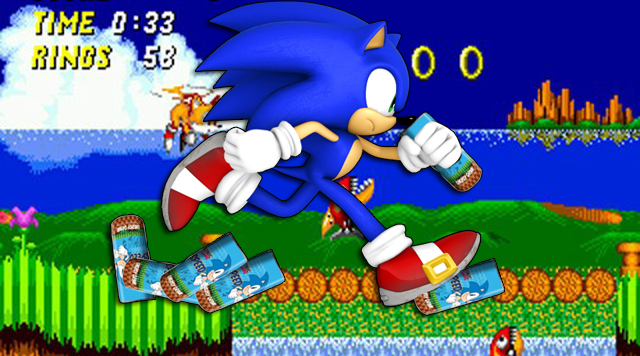
Somewhere in Japan, where the legal age to drink alcohol is 20, Sonic the Hedgehog is looking down at an empty beer bottle and reflecting on his life. His speedy ascent began this month in 1991, which means, right about now, his friends Tales and Knuckles are reminiscing with him about the good ol' 16-bit days. Joining them in that celebration with a trip down memory loop-de-loop, we take a look back at all of the major games that Sega's quick-footed mascot has appeared in, starting with his very first Sega Genesis game.
The Genesis Generation
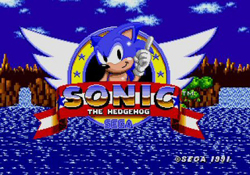
Sonic's self-titled Sega Genesis / Master System game made him out to be the faster, cooler and skinnier alternative to Mario. The Sonic Team-developed character was all about finishing his 2D stages as quickly as possible and collecting rings as hit-point collateral. From Green Hill Zone to Dr. Robotnik's lair, the platforming gameplay in Sonic the Hedgehog felt fresh. Likewise, the rush from the graphics helped springboard it beyond anything Mario was doing. Sega had a hit on its hands and nothing proved that more than the power-selling Genesis and Sonic the Hedgehog bundles during the company's landmark 1991 holiday season.
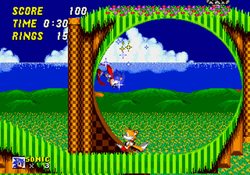
With Sonic on his way to outpacing his chief enemy, Mario, Sega brought him back to face off against his Chaos Emerald-stealing foe, Dr. Robotnik, in Sonic the Hedgehog 2. This 1992 Sega Genesis title marked the 16-bit debut of Miles "Tails" Prower, an orange-colored fox with two tails. They enabled him to hover over stage areas that Sonic was unable to explore. The addition of a sidekick also meant that a friend could get in on the 2D platforming action for the first time with select 2P levels. Another significant change happened behind the scenes, as development of the expanded game shifted from Japan to California, where the newly formed Sega Technical Institute was located.
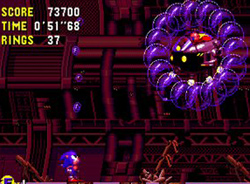
Series off-shoots Sonic Spinball and Dr. Robotnik's Mean Bean Machine in 1993 meant that there was no third Sonic game on the Sega Genesis that year. Instead, Sonic CD came for the newly released Sega CD add-on for the console. But the limited videogame library for this device, and the fact that Sonic CD was the sole Sonic title, meant that many people chose not to own a Sega CD and therefore didn't get to play Sonic CD until it was ported to the GameCube as part of the Sonic Gems Collection in 2005.
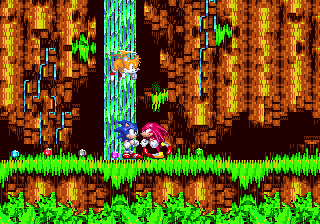
It wasn't until February 2, 1994, dubbed by Sega as "Hedgehog Day," that Sonic fans received a true sequel in the form of Sonic the Hedgehog 3. Sega more than made up for it, though. In addition to developing this critically-acclaimed Sonic title, the company put out the another game in October of that year: Sonic & Knuckles. Knuckles, a new character in the Sonic universe, starred in Sonic 3 and became a playable in the game in Sonic & Knuckles. The short development cycle of the latter game was due to the fact that Sonic 3 and it were developed as a single title. The limitations of a standard cartridge, however, forced Sega to split up the two games and resort to lock-on technology. The cartridge for Sonic & Knuckles actually opened up at the top, allowing players to mount Sonic 2 or Sonic 3 and play as Knuckles in either game.
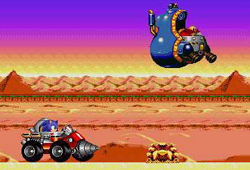
Game Gear had its share of solid platforming titles featuring Sonic, demonstrating that the colorful handheld could keep up with its console equivalent. Sonic 1, Sonic 2, Sonic Chaos and Sonic Triple Trouble scaled down the graphics for this 8-bit system system, but kept the speedy 2D gameplay intact. It wasn't until 1995 that Sega made the mistake of attempting a 3D isometric Sonic game, Sonic Labyrinth, which marked the beginning of the end of classic Sonic the Hedgehog titles as we knew them.
The Sad, Sad Sega Saturn era
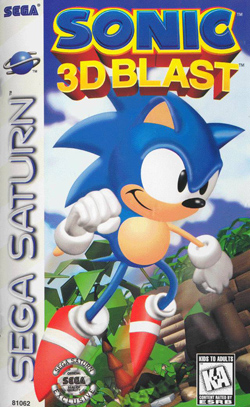
The overpriced and unaffordable Sega Saturn was rushed to the market in 1995 to compete with the Sony PlayStation and its CD technology, making Sonic a casualty of the effort. Sega Technical Institute was supposed to release Sonic X-treme, but a touch of the Duke Nukem Forever flu put it in development hell, never to be released. Instead, Sonic 3D Blast, which released on both Genesis and Saturn in 1996, brought Sega's mascot into an isometric third dimension for the entire game (not just a bonus level) first time on a home console. Speed, special stages and ring collecting were still a part of the gameplay on the new brand system, but playing at such an odd angle was not flattering for the blue hedgehog.
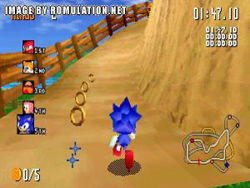
Traveller's Tales, currently known as the developer behind the LEGO games, co-developed Sonic 3D Blast with the Sonic Team. The company rolled up its sleeves and decided to give the hedgehog another go in a completely new genre: racing. That's what the "R" stood for in Sonic R, a Saturn game released in December 1997 and later ported to the PC. Taking advantage of Sonic's blazing speed, the idea to run, and for some characters fly, along courses was intended to ape Mario Kart. The concept was mildly successful for what it was, but unlike the platforming genre six years prior, Sega and Sonic were not able to outpace Nintendo's Italian plumber in this field.
A Re-Do on the Dreamcast
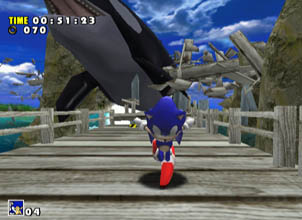
With PlayStation dominating the videogame space and Nintendo doing what it could to help bury the Saturn with the N64, Sega had to retool its properties with a new system. That happened in North America on 9.9.99, when the company launched Dreamcast with a killer lineup fronted by Sonic Adventure. The Sonic Team was finally successful in developing a 3D platformer and, at the same time, gamers once again felt the sense of speed from their favorite blue-haired videogame character. Sonic wasn't the only playable character, though. Tails, Knuckles, Amy, Big and E-102 Gamma could be selected in this free-roaming game, where speed, unrestricted 3D movement and 128-bit graphics met for the very first time. It's hard to forget being chased by a giant whale that is tearing apart the dock behind you.
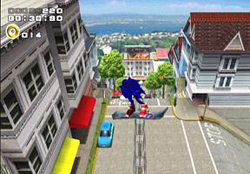
Always with Mario in his sights, Sonic cloned Mario Party with Sonic Shuffle in 2000, a not-so-entertaining attempt to capitalize on the whole mini-game craze. The real focus was on Sonic Adventure 2, released in June 2001. This sequel expanded the 3D environments of the first game, featured spiffier graphics, gave Sonic the ability to grind rails and snowboard through certain stages and added new "Dark" characters Shadow the Hedgehog and Rouge in addition to a playable Dr. Eggman - the new name for Dr. Robotnik. The exploration levels of Knuckles and Rouge and the camera issues aside, this was another hit for the Sonic Team. Sadly, it wasn't enough to save the Dreamcast or Sega's future as a first-party company. This became the last major Sonic game for the system before Sega moved to develop games for its rivals.
From Foes to Friends: Sonic On Rival Systems
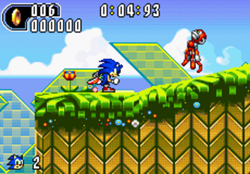
Once a staunch opponent on Sega Game Gear, Sonic's first stop as a third-party mascot was on Game Boy Advance in 2002. The appropriately titled Sonic Advance brought the blue hedgehog back to his 2D roots with a fast-paced platform game that was completely original. Its success on the Nintendo handheld ensured sequels in 2002 and 2004, as Sonic Advance 2 and Sonic Advance 3 made their way onto GBA, too. When Nintendo DS arrived to retire the Game Boy legacy, Sonic didn't retire with its former hardware rival. It moved to the dual-screen system with Sonic Rush in 2005 and Sonic Rush Adventure in 2007. Both were co-developed by portable developer Dimps, which worked on Sonic Advance games, and marked the first games in the Sonic to be 2.5D. The pair of games also introduced new characters Blaze the Cat and Marine the Raccoon in addition to using the new hardware's second screen to project even more of the level, including loop-de-loops in full frame.
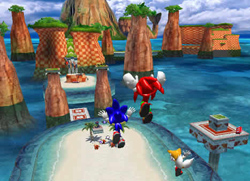
Sonic became an equal opportunity third-party mascot in 2004 with the release of Sonic Heroes on GameCube, PS2 and Xbox at the same time. And for this first console experience outside of a Sega box, Sega changed up the platforming gameplay dramatically. Instead of controlling one character at a time, players had the chance to use up to three - one in the front with the other two swappable friends tagging behind. Team Sonic consisted of Sonic, Tails and Knuckles; Team Dark included Shadow, Rouge and E-123 Omega; Team Rose had Cream the Rabbit with her Choa, and Big the Cat; finally, Team Chaotix was made up of Espio the Chameleon, Charmy Bee and Vector the Crocodile. The groups form a speed-flight-power trio that players had to use to their advantage in the game's 3D levels. Although Sonic didn't have a great track record in 3D, these levels were streamlined for speedy gameplay, so the game, despite its odd, three-character formula, recalled to the series' roots.
Sonic Struggles: To the Next-Gen We G...D'oh
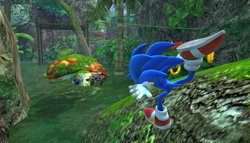
Attempting to further recall its roots, the Sonic Team developed a new game for next-gen systems Xbox 360 and PS3, released in 2006 (the PS3 version slipped to 2007 here in the States), and simply titled it "Sonic the Hedgehog." There was a game called Shadow the Hedgehog in between Sonic Heroes and this new game, but that didn't contain our main man, Sonic, and instead bizarrely added guns to the 3D platforming mix. Sonic the Hedgehog, conversely, was all about Sega's kid-friendly character with attitude. Unfortunately, this 3D platformer didn't feel much like a throwback to the old Sonic either because the final product felt unfinished. Unexcuseable bugs, a horrible camera and painful load times on the new systems made it obvious that the team rushed the game to meet a holiday deadline. It was also evident that the series had hit rock-bottom - the new Sonic the Hedgehog was the ultimate low-point for Sega's best-known franchise.
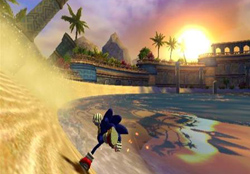
Luckily, Sega opted not to port Sonic the Hedgehog to Nintendo's Wii console in 2007 and, instead, created a brand new game that made use of the new systems motion controls. That game was Sonic and the Secret Rings. It's story drew inspiration from the Arabian Nights, with Middle East-set levels that gave the series something new in the way of presentation. Thankfully, the gameplay remained on track - literally - by being on rails. Players were able to increase Sonic's momentum, put on the brakes, jump and perform homing attacks by tilting the Wii remote in various directions. Most importantly, none of these new play controls applied to Sonic's friends; they weren't playable in this solo-character experience.
Seeing some success on the Wii, Sega decided to follow up its Arabian Nights-inspired game with 2009's Sonic and the Black Knight. It was based on King Arthur and therefore included swordplay, a new concept for the speed-driven series. The new mechanics weren't as highly praised as the jump-and-dash gameplay of Secret Rings, but Sonic on the Wii represented a better direction for the character compared to his abysmal beginnings in this new generation.
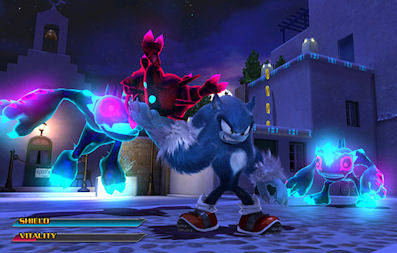
Case in point, in between Wii's closely tied Secret Rings and Black Knight games came Sonic Unleashed on Xbox 360, PS3, Wii and PS2 in 2009. It held promise of restoring the chili dog-loving character to his glory days with tons of adrenaline-rushing gameplay that once again had players dashing through levels that seamlessly transitioned between 3D and 2D. But that was only half of the story. The other half, bizarrely, had Sonic take on other form: a werewolf-like Werehog. Worse than mutanizing one of gaming beloved favorite mascots, slowed down gameplay really turned this title into a hideous beast, as the changed Sonic had to duke it out with enemies using stretchable arms in night-time levels. Sonic Unleashed, sadly, isn't remembered for its speed-driven better half.
Bouncing Back in the New Decade
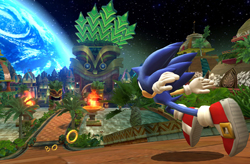
Sonic Colors, a 2010 Wii game that also saw a version release on Nintendo DS, cured Sonic of his Werehog woes. A mix of streamlined 3D and 2D levels gave players the chance to rail-grind and ring-collect, tossing out the blue blur's dull exploration gameplay. It seemed as if the Wii-exclusive console games were having better luck with The Fastest Thing Alive by sticking with what Sonic does best: speeding through levels as quickly as possible.
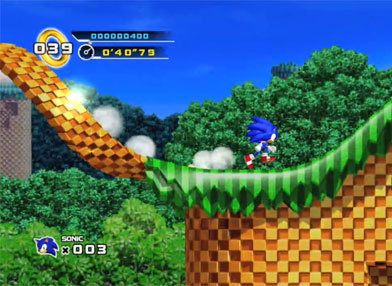
That all changed with the release of Sonic the Hedgehog 4. How do you change the course of a videogame series fallen on hard times? By going back to where it all went downhill and making a direct sequel to the game right before that point in time - in this case, 1994's Sonic 3. Of course, times had changed, so this strictly 2D side-scroller came out on XBLA, PSN WiiWare, iOS and, eventually, even Windows Phone 7. It also released - or is supposed to release - in episodes. Episode I came out in 2010 and we're still awaited word on the development of Sonic the Hedgehog 4: Episode II.
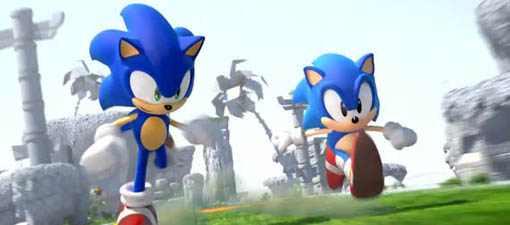 The Inside Scoop on the Future of Sonic
The Inside Scoop on the Future of Sonic
The Sonic 4: Episode II delay may be because the Sonic Team has been intensely focused on Sonic Generations. This upcoming Xbox 360, PS3 and Nintendo 3DS game will star both the classic Sonic and his newer, learner-looking character model. When I first played the game at a Pre-E3 Sega event in May, I asked the PR rep, "I just finished the first level, but is there more to this demo?" She replied with a question for me, "There's another level as the other Sonic. Which version of Sonic did you just play as, fat Sonic or skinny Sonic?" I didn't know the original Sonic the Hedgehog was considered fat, especially when comparing him to a chubby plumber back in 1991.
Alas, it's true. Sonic has silently been on an unannounced diet over the last two decades and looks fitter and, more agile than he did 20 years ago. It wasn't until we saw his the two generations side by side, courtesy of the story's time-traveling narrative, that we see the real difference, as if these were before and after photos from The Biggest Loser. Thankfully, both Classic Sonic and Modern Sonic run through levels with no regard for speed limits, and contain only minor (read: welcomed) tweaks. For example, Modern Sonic adds homing attacks and drifting to his gameplay repertoire and he travels on both 2D and 3D planes. Best of all, there's no dull 3D exploration to be had in this streamlined effort.
Sonic Generations releases on November 22, but there are games with farther release dates in The Fastest Thing Alive's future. Besides Sonic 4: Episode II, Sega announced a different Sonic 3DS game at E3 2010 and we're still waiting to hear how that game takes advantage of the glasses-free system's capabilities. Likewise, the new technology PS Vita and Wii U means that the Sonic Team is probably hard at work. It'll be interesting to see how the developer utilizes the novel 6.2-inch touchscreen controller in time for the Nintendo system's 2012 launch.
Sonic the Hedgehog ascended to fame very quickly only to lose all of his rings during Sega's sophomore console generation. His Dreamcast outings and third-party ventures, with the exception of Sonic the Hedgehog and Sonic Unleashed, have been worthwhile games to play and Sonic Generations looks to be no different. This means that the road ahead for Sonic fans isn't as bad as some people make it out to be. As long as he doesn't stray from what made his famous in the first place, there'll always be a place for the blue blur.